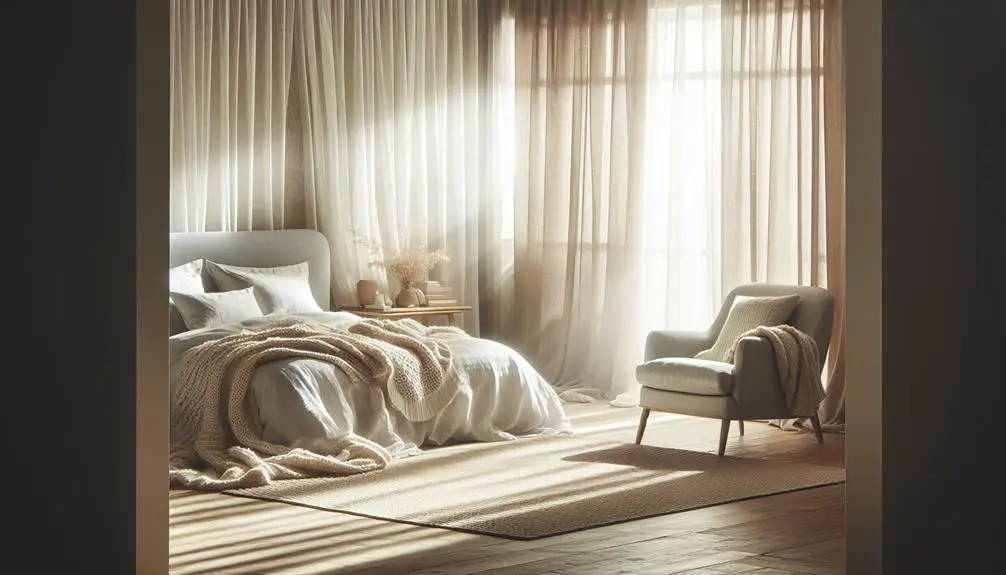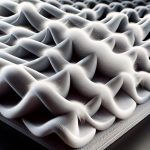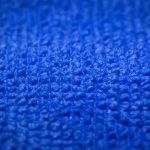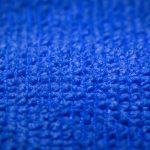When you think about your daily comfort, the fabrics you choose play an essential role. From the softness of cotton to the natural insulation of wool, each material offers distinct benefits that can enhance your well-being. Silk, with its luxurious texture, not only feels good but also promotes better sleep, while linen keeps you cool and dry. Bamboo stands out for its eco-friendly and antibacterial properties, contributing to a fresher experience. Advanced options like microfiber add durability and ease of care. But what makes one fabric more advantageous than another, and how do they impact your health in ways you might not expect?
Table of Contents
Key Takeaways
- Natural fabrics like cotton, wool, silk, and linen provide excellent breathability, moisture-wicking, and temperature regulation for enhanced comfort.
- Organic cotton offers a softer, environmentally friendly option, reducing the negative impact of conventional cotton farming on wellness.
- Wool naturally insulates, regulates temperature, and is sustainable, making it ideal for comfort in varied climates.
- Silk's hypoallergenic properties and smooth texture reduce skin irritation and promote restorative sleep, benefiting skin and hair.
- Bamboo fabric is eco-friendly, antibacterial, and odor-resistant, supporting sustainable and comfortable living.
Cotton: Softness and Breathability
You can't go wrong with cotton if you're looking for a fabric that's both soft and breathable. Its natural fibers provide a comfort level that's hard to match, making it a top choice for everything from everyday wear to luxurious bedding. When it comes to mastering your wardrobe, cotton's versatility in fashion can't be overstated. You can find it in a wide range of clothing, from casual T-shirts to elegant dresses, making it an indispensable part of any savvy dresser's collection.
However, it's crucial to take into account cotton's environmental impact. Conventional cotton farming requires significant water and pesticide use, which can harm ecosystems and deplete natural resources. But don't let that deter you; choosing organic cotton can make a substantial difference. Organic cotton is grown without harmful chemicals and uses sustainable farming practices, reducing its environmental footprint.
Mastering the use of cotton means balancing its unparalleled comfort and versatility with a mindful approach to its environmental consequences. By choosing organic options and supporting sustainable brands, you can enjoy the benefits of this remarkable fabric while contributing to a healthier planet.
Embrace cotton's softness and breathability, but do so responsibly.
Wool: Natural Insulation
While cotton offers breathable comfort, wool stands out for its exceptional natural insulation properties. Wool's ability to regulate temperature makes it a top choice for maintaining warmth in cold weather and coolness in warmer climates. This eco-friendly fabric provides insulation benefits that enhance your overall comfort and wellness.
Wool is incredibly versatile. It can be woven into a variety of textures and weights, making it suitable for everything from light summer garments to heavy winter wear. Additionally, wool's sustainable properties mean that you're choosing a fabric that benefits both you and the planet. Wool is biodegradable and renewable, sourced from sheep that are shorn annually without harm.
When you incorporate wool into your wardrobe, you're investing in a material that excels in moisture-wicking and breathability, reducing the risk of clamminess. This makes wool an ideal choice for active wear and outdoor activities. Besides, wool is naturally resistant to odors and stains, requiring less frequent washing and thereby conserving water and energy.
Silk: Luxury and Skin Benefits
Renowned for its luxurious feel and myriad skin benefits, silk stands as a premier fabric choice for those seeking both comfort and elegance. When you opt for silk, you're not just indulging in luxury; you're also prioritizing your skin's well-being.
Silk's smooth texture reduces friction against your skin, which can minimize irritation and help prevent fine lines and wrinkles. This makes silk an excellent option for pillowcases and sleepwear, ensuring that your skin remains soft and unblemished.
Beyond its tactile appeal, silk is naturally hypoallergenic. This means it resists dust mites, molds, and other allergens, making it ideal for individuals with sensitive skin or allergies. Additionally, silk has impressive moisture-wicking properties, which help regulate your body temperature and keep your skin hydrated. This is particularly beneficial for those prone to dry or irritated skin.
Moreover, silk's protein structure contains amino acids that mirror those found in human skin and hair, promoting restorative sleep and enhancing your overall skincare routine. By incorporating silk into your daily life, you're not just embracing a fabric of unparalleled luxury; you're also investing in your skin's health, achieving a harmonious blend of comfort and care.
Linen: Cooling Comfort
Linen, a fabric revered for its exceptional breathability and cooling properties, offers unmatched comfort, particularly in hotter climates. If you're looking for a material that promotes a feeling of cool serenity, linen is your solution. Its natural fibers wick away moisture, keeping you dry and at ease even on the warmest days.
For those who prioritize a good night's rest, linen bedding can be revolutionary. Its capacity to regulate temperature guarantees you remain cool in summer and cozy in winter, delivering seasonal adaptability that's unparalleled.
Mastering linen care is simple yet crucial for preserving its advantages. Always wash linen in lukewarm water and refrain from using harsh detergents. Air drying maintains its durability and improves its gentle texture over time. Ironing while slightly damp will keep it free of wrinkles, although many value linen's natural, laid-back appearance.
Linen's sleep benefits go beyond just temperature management. Its hypoallergenic properties make it perfect for delicate skin, reducing irritation and encouraging peaceful sleep. Embrace linen for a lavish, health-boosting experience that seamlessly adjusts to your requirements, whether you're relaxing at home or seeking revitalizing rest.
Linen's enduring charm and functional benefits make it a must-have for anyone dedicated to comfort and well-being.
Bamboo: Eco-Friendly and Antibacterial
You'll find bamboo fabric to be both eco-friendly and naturally antibacterial.
It's produced using sustainable growth practices, making it a great choice for the environmentally conscious.
Plus, its natural odor resistance means you'll stay fresh longer.
Sustainable Growth Practices
How does bamboo, with its eco-friendly and antibacterial properties, contribute to sustainable growth practices in the fabric industry? It starts with ethical sourcing. Bamboo grows rapidly without the need for harmful pesticides or excessive water, greatly reducing its environmental impact. By choosing bamboo fabrics, you're supporting a process that's kinder to the planet.
Moreover, the fair trade practices employed in bamboo cultivation ensure that farmers receive fair wages and work under safe conditions, promoting social responsibility. When you opt for bamboo textiles, you're not just getting a sustainable product; you're also endorsing a system that values the well-being of the workers involved. This symbiotic relationship between the environment and social ethics sets bamboo apart as a leader in sustainable fabrics.
Incorporating bamboo into your wardrobe or home decor helps reduce your carbon footprint. Its natural antibacterial properties also mean less frequent washing, conserving water and energy. By making this conscious choice, you contribute to a more sustainable and socially responsible textile industry.
Natural Odor Resistance
Not only is bamboo fabric sustainable, but its natural odor resistance also makes it an ideal choice for anyone looking to reduce laundry frequency and stay fresh longer. You'll appreciate how the natural fibers in bamboo offer unparalleled odor prevention, thanks to their inherent anti microbial properties. This means you can wear your bamboo garments more often without worrying about unpleasant smells.
Imagine the freedom of not having to constantly wash your clothes. Bamboo fabric technology has advanced to the point where it's not just about sustainability; it's about enhancing your daily comfort and well-being. The anti microbial properties embedded in bamboo fibers actively combat bacteria, ensuring you stay fresh and hygienic.
Here's a quick comparison to highlight the benefits:
| Feature | Bamboo Fabric |
|---|---|
| Odor Prevention | Exceptional |
| Anti Microbial Properties | Natural and Effective |
| Sustainability | Highly Eco-Friendly |
| Softness | Luxuriously Soft |
| Laundry Frequency | Markedly Reduced |
Choosing bamboo fabric means you're investing in a material that works hard to keep you comfortable and fresh. Embrace the advanced fabric technology that bamboo offers and enjoy the convenience and peace of mind that comes with it.
Microfiber: Durability and Absorbency
When you think about microfiber, you'll appreciate its superior durability and impressive absorbency.
This fabric not only withstands wear and tear but also excels in soaking up liquids quickly.
Plus, it's incredibly easy to maintain, making it a practical choice for everyday use.
Superior Durability Qualities
Microfiber stands out for its exceptional durability and impressive absorbency. Its long-lasting performance guarantees that you get the most out of your investment, making it a wise choice for various applications. Whether you're looking for fabrics to withstand daily wear and tear or seeking materials that maintain their form and function over time, microfiber's superior durability makes it indispensable.
To better understand microfiber's durability and absorbency, consider the following comparison:
| Property | Microfiber |
|---|---|
| Durability | High |
| Absorbency | Excellent |
| Wear Resistance | Superior |
| Maintenance | Easy |
| Versatility | Extensive Applications |
When you choose microfiber, you're selecting a fabric known for its strength and resilience. It can withstand repeated washing and drying cycles without compromising its integrity. This means fewer replacements and lower long-term costs. Its versatile applications range from upholstery to athletic wear, showcasing its adaptability across different needs and environments.
You'll appreciate microfiber's easy upkeep and the way it retains its appearance and performance over time. This fabric's durable qualities meet the demands of an active lifestyle while providing comfort and reliability, making it an essential component in various wellness and comfort-related products.
High Absorbency Features
Alongside its remarkable durability, you'll find microfiber boasts high absorbency, making it ideal for a range of practical applications. This fabric excels at moisture management, ensuring you stay dry and comfortable even during intense activities. Its quick-drying nature means that whether you're using it for cleaning, clothing, or bedding, you won't have to wait long for it to be ready for use again.
Microfiber's high absorbency isn't just about comfort; it also offers significant hygienic properties. The fabric's anti-microbial qualities help to reduce the growth of bacteria, making it a cleaner choice for your home and personal items. This is particularly beneficial in environments where hygiene is paramount, such as in hospitals or gyms.
You'll find microfiber's high absorbency advantageous in various scenarios:
- Cleaning: Efficiently picks up spills and dirt, leaving surfaces spotless.
- Athletic wear: Wicks away sweat, keeping you dry during workouts.
- Home textiles: Quickly absorbs moisture, perfect for towels and bath mats.
Easy Maintenance Benefits
You'll appreciate how simple it's to maintain microfiber, thanks to its durability and high absorbency. Microfiber stands out as a prime example of easy care fabrics, providing you with both convenience and longevity. Its stain-resistant properties mean you won't spend hours scrubbing spills or worrying about unsightly marks. Simply wipe away most stains with a damp cloth, and you're good to go.
Moreover, microfiber is known for being one of the most wrinkle-free textiles available. This characteristic makes it an excellent choice for those who value a polished look without the hassle of constant ironing. Imagine enjoying the benefits of low maintenance materials that retain their shape and appearance effortlessly.
The durability of microfiber also secures that your items will last longer, resisting wear and tear better than many other fabrics. This makes it a sustainable choice, reducing the need for frequent replacements.
Additionally, its high absorbency is perfect for tasks ranging from cleaning to personal care, making it a versatile addition to your fabric collection.
Modal: Smooth and Lightweight
When you touch modal fabric, you'll immediately notice its unparalleled smoothness and lightweight feel. This fabric is a game-changer for those who prioritize comfort and functionality in their wardrobe. Modal is versatile and stretchy, making it perfect for a wide range of clothing items, from everyday wear to high-performance activewear. Its flexibility allows you to move freely without restriction, enhancing your comfort throughout the day.
One of the standout features of modal is its eco-friendly and breathable nature. Derived from beech tree pulp, modal production uses a notably smaller amount of water than other fabrics, making it a sustainable choice. Additionally, its breathable qualities guarantee that you stay cool and dry, further contributing to your overall comfort.
Consider these key benefits of modal:
- It's incredibly soft to the touch, providing a luxurious feel against your skin.
- It maintains its shape and color even after multiple washes, ensuring longevity.
- It resists wrinkling, which means less ironing and maintenance for you.
Hemp: Sustainable and Strong
While modal offers a silky, smooth experience, hemp stands out for its sustainability and impressive strength. When you choose fabrics, you're not just thinking about texture but also the impact on the environment and the durability of the material. Hemp fabric not only excels in these areas but also brings versatility to your wardrobe and home.
Hemp is renowned for its eco-friendly properties. It requires less water to grow compared to cotton and thrives without the need for pesticides. This makes it a stellar choice if sustainability is a priority for you. Additionally, hemp fabric is incredibly strong and long-lasting, ensuring that your clothing and textiles remain in top condition for years.
Here's how hemp compares to other fabrics:
| Fabric | Sustainability | Strength |
|---|---|---|
| Hemp | High | Very High |
| Cotton | Moderate | Moderate |
| Modal | High | Low |
| Polyester | Low | High |
With its superior sustainability and strength, hemp fabric is also highly versatile. From clothing to home decor, hemp seamlessly fits into various applications, giving you both style and durability. Embrace hemp, and you'll be investing in a fabric that's as kind to the planet as it is to your lifestyle.
Frequently Asked Questions
How Do Fabric Blends Affect the Wear and Longevity of Clothing?
When considering fabric durability and comfort, textile blends are essential. The right fabric composition can enhance wear and longevity. You'll find that combining natural and synthetic fibers often balances durability and comfort, extending clothing life.
Are There Any Fabrics That Can Help Reduce Static Electricity?
Think of static electricity like a pesky mosquito. To reduce it, you should choose natural fabrics over synthetic ones. Natural fibers are more conductive, while synthetic ones are insulating, making them more prone to static buildup.
What Fabrics Are Best for People With Sensitive Skin?
For sensitive skin, you should opt for silk alternatives and hypoallergenic options like organic cotton, bamboo, or TENCEL. These fabrics are gentle, breathable, and less likely to cause irritation, ensuring ultimate comfort and care.
How Do Different Fabrics Impact the Environment During Production?
You wouldn't believe the environmental carnage that unsustainable fabric production wreaks. However, by embracing sustainable practices, you can drastically reduce the environmental impact, ensuring a greener planet while mastering eco-friendly choices in your everyday life.
Are There Fabrics That Provide UV Protection for Outdoor Wear?
Yes, you'll find fabrics that provide UV protection for outdoor wear. Look for options like polyester and nylon, which often feature moisture-wicking properties and breathable comfort, ensuring you stay cool and protected under the sun.
- How Does Ring Spun Cotton Affect Garment Fit and Shape Retention? - August 13, 2024
- What Are the Challenges in Producing Ring Spun Cotton? - August 13, 2024
- Is Ring Spun Cotton Suitable for Plus-Size Clothing? - August 13, 2024







